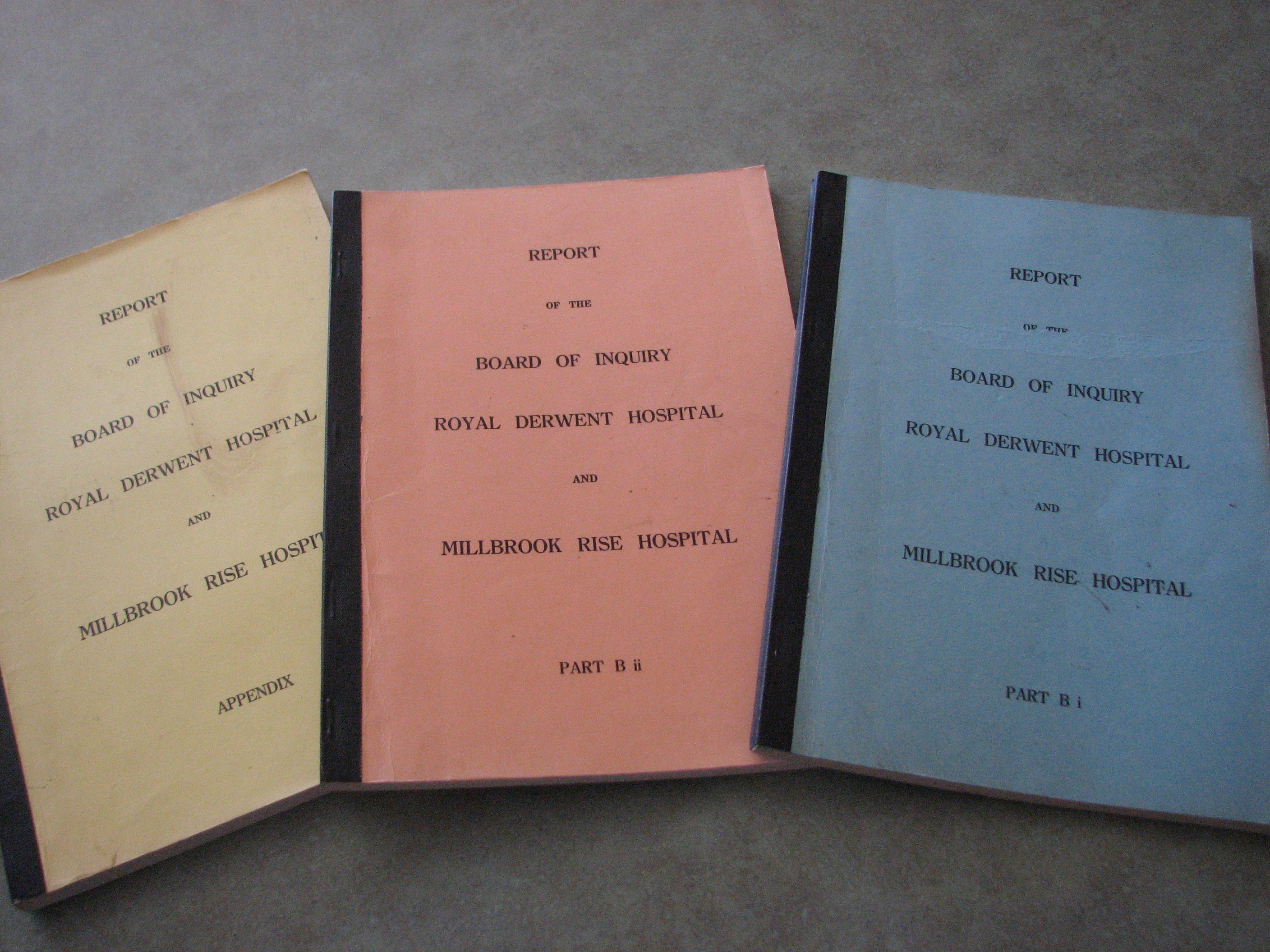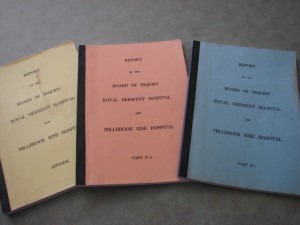
These are three volumes and form part of the final unpublished report from the Board of Inquiry into the treatment practices at Royal Derwent Hospital and Mill Brook Rise Hospitals. Concluded approximately in 1979 the report heard from a number of parents and witnesses that had issues with the treatment and the duty of care of the hospital staff. Each witness was cross-examined in this formal hearing as were those accused of mistreatment and those that had seniority within the management structure. Some cases were dismissed and some were found to be correct accounts of what had occurred. The document draws heavily from the xerox transcript of evidence given by each participant. The Board had the power to summons witnesses to give evidence and it was clear that this was used to get reluctant witness to be interviewed and cross-examined. While there are many mixed views of the Hospital and it’s care provision throughout it’s life there were many inquiries both formal and in-formal held in the life of the institution.
Susan Piddock is an Australian renowned published author and authority on Australian Asylums and is studying Asylums throughout Australia. She has a keen interest in comparing institutions that started from a Convict past to those that had a free settler past as she believes there are key fundamental differences in the care provided through to the look and feel of the buildings. While that history is being written within academic circles the general history of each institution around Australia is being written, often by ex-staff who have/had a passion for the care provision given to patients who were admitted to institutions such as Royal Derwent Hospital.
One of my questions has always been, who is writing the history? It is often said that the victor writes the history of any human struggle and so that history will reflect one view, one perception of events. Often the patients that attended such institutions could not write the history and still would be limited to do so. This is were these documents come into play because they offer an evidence based and cross examined view of the events, judged by people whom have the qualifications, impartiality and experience to write this part of the history.
Of coarse there has to be a context and the documented witnesses even testify to the hard work and dedication of the majority of staff providing care withing these institutions. Also there needs to be a context of time around these documents, what was acceptable practice at the time and what is now? While many would view these documents as negative, they are part of the history, as mixed as it was. They serve the voiceless patients of this institution and those like it by looking into and investigating complaints, verifying and validating some experience and clearing the institution of any wrong doing in other cases.
Is this only valid for historical institutional settings or is it still valid today? It has become clear that where there are vulnerable people their will be abuse, it is a history that is still repeating it self today as it was in 1979 or 1879 for that matter. Resent cases in the United Kingdom serve as clear examples of abuse to a vulnerable population. So if the majority of people don’t participate in abusing actions or cover ups, why don’t they speak out? It is said that up to 70% of people will not get involved when there is an abuse being perpetrated and most fear in someway for reprisals should they step up to the mark and become that witness. History has also told that this is possible and probable when strong and aggressive personalities are allowed to permeate a care setting.
Undercover Care: The Abuse Exposed was a classic case of a workplace culture that was out of control and dominated by a small number of staff. Elder Abuse; Panorama BBC was another care provider that was exposed as delivering services that were abusing and less then best practice. Yet in an interview with Doctor Sheridan Forster in 2010 Dr Forster expressed that the best care provider for people with multiple learning disabilities PMLD that she has witnessed was an institution in the Netherlands. Dr Forster is one of Australia’s leading Academics in the support of PMLD here in Australia and has traveled and studied extensively in many countries. So it is not the institution that is abusive but the culture within a workplace/home that leads to less then best practices.
How does a care provider ensure that every step is taken to never expose a vulnerable person to abuse? We have criminal police checks, which most places, if not already mandatory, will have a policy and procedure in place to eliminate potential staff with relevant histories that have been historically exposed. Regular and unannounced visits from family, management and advocates should be welcomed in any care establishment and should be embedded within the culture of the home. A connection between the ever increasing divide of staff and management should be encouraged and employment practices should be reviewed inline with the latest evidence base practice. Strong laws that allow people with disabilities, especially those with intellectual disabilities to participate within the legal system. Whistle blower policy and procedures and independent investigation of suspicions activity and allegations should be funded and available. Support staff should also educate people to communicate about abuse when they recognise it.


